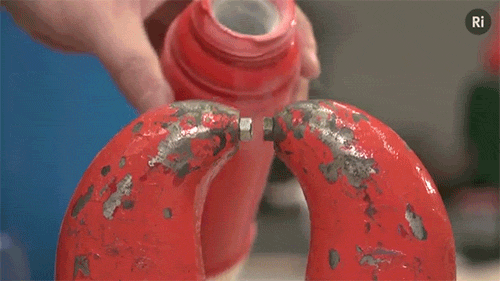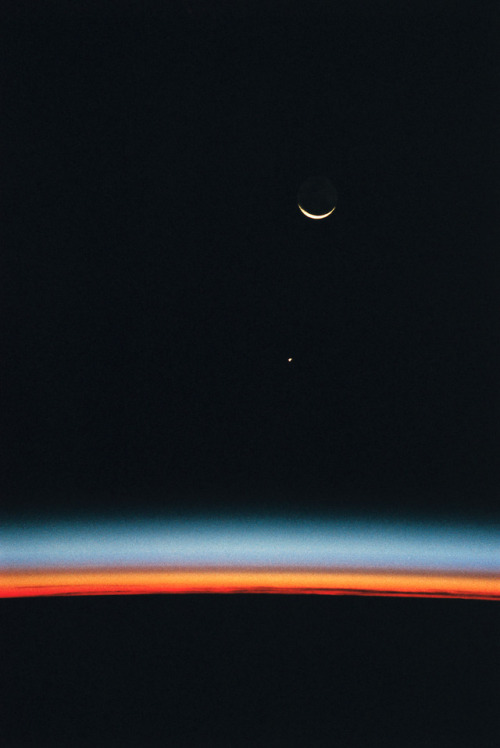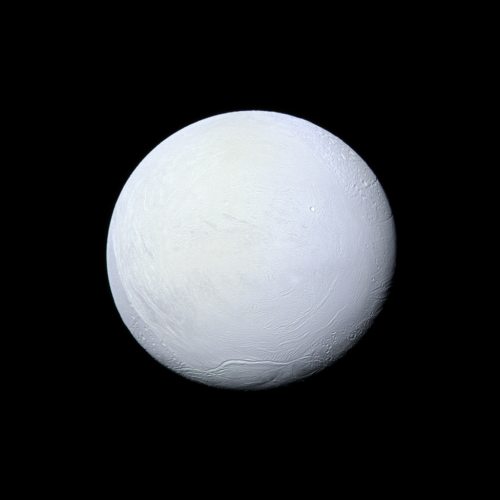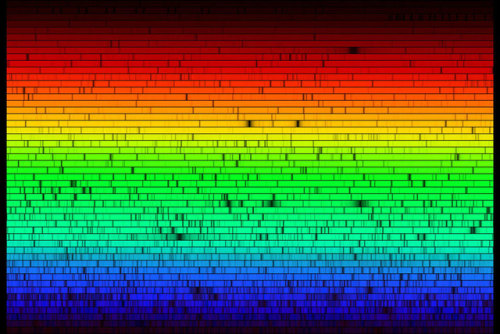Riekod - 里枝子

More Posts from Riekod and Others


Take a mixture of a viscous liquid – like clay mud – and squeeze it between two glass plates and you’ll create a mostly-round layer of liquid. As you pry the two glass plates apart, air will push its way into that layer, forcing through the mud in a dendritic pattern. This is called the Saffman-Taylor instability or viscous fingering. It occurs because the interface between the air and mud is unstable. (Image and video credit: amàco et al.)


Liquid oxygen is magnetic
Liquid oxygen sticks between the poles of a strong magnet until it boils away into its gas state. This is because it has unpaired electrons, which make each oxygen molecule a tiny magnet with a dipole. Normally, when oxygen is in a flask or in the air, these microscopic magnets point in all directions, cancelling out and meaning that there’s no net magnetic field. When it pours over the permanent magnet, the magnetic molecules all slightly align, creating an induced magnetic field, which reacts with the permanent magnet, making the oxygen stick to the poles. This is called paramagnetism. Click here to watch the video.









What Will Happen When Betelgeuse Explodes?
“Every star will someday run out of fuel in its core, bringing an end to its run as natural source of nuclear fusion in the Universe. While stars like our Sun will fuse hydrogen into helium and then – swelling into a red giant – helium into carbon, there are other, more massive stars which can achieve hot enough temperatures to further fuse carbon into even heavier elements. Under those intense conditions, the star will swell into a red supergiant, destined for an eventual supernova after around 100,000 years or so. And the brightest red supergiant in our entire night sky? That’s Betelgeuse, which could go supernova at any time.”
One of the most sobering cosmic truths is that every star in the Universe will someday run out of fuel and die. Once its core fuel is exhausted, all it can do is contract under its own gravitational pull, fusing heavier and heavier elements until it can go no further. Only the most massive stars, capable of continuing to fuse carbon (and even heavier elements) will ever create the Universe’s ultimate cataclysmic event: a Type II, or core collapse, supernova. Stars that are fusing carbon (and up) appear to us today as red supergiants, and the brightest red supergiant as seen from Earth is Betelgeuse. Sometime in the next 100,000 years or so, Betelgeuse will go supernova. When it does, it will emit incredible amounts of radiation, become intrinsically brighter than a billion suns and and be easily visible from Earth during the day. But that’s not all.
What’s the full story on what will happen when Betelgeuse goes supernova? Come get the science today!

This scene, captured with a 35mm camera from inside the Space Shuttle Endeavour, shows Jupiter rising above the airglow over Earth’s horizon. The crescent Moon is at top frame.
Credit: NASA

Declining Arctic sea ice: The 2018 Arctic Report Card found the Arctic region had the second-lowest overall sea-ice coverage on record. The map shows the age of sea ice in the Arctic ice pack in March 1985 (left) and March 2018 (right). Ice that is less than a year old is darkest blue. Ice that has survived at least 4 full years is white. Maps were provided by NOAA Climate.gov and based on data provided by Mark Tschudi./University of Colorado/CCAR. (NOAA Climate.gov)
Excerpt from this Washington Post story:
Over the past three decades of global warming, the oldest and thickest ice in the Arctic has declined by a stunning 95 percent, according the National Oceanic and Atmospheric Administration’s annual Arctic Report Card.
The finding suggests that the sea at the top of the world has already morphed into a new and very different state, with major implications not only for creatures such as walruses and polar bears but, in the long term, perhaps for the pace of global warming itself.
The oldest ice can be thought of as a kind of glue that holds the Arctic together and, through its relative permanence, helps keep the Arctic cold even in long summers.
“The younger the ice, the thinner the ice, the easier it is to go away,” said Don Perovich, a scientist at Dartmouth who coordinated the sea ice section of the yearly report.
If the Arctic begins to experience entirely ice-free summers, scientists say, the planet will warm even more, as the dark ocean water absorbs large amounts of solar heating that used to be deflected by the cover of ice. The new findings were published as climate negotiators in Poland are trying to reach a global consensus on how to address climate change.
In March, NASA scientists with the Operation IceBridge mission, which surveys the polar regions using research aircraft, witnessed a dramatic instance of the ongoing changes. Flying over the seas north of Greenland, in a region that usually features some of the oldest, thickest ice in the Arctic, they instead saw smooth, thin strips binding together the thicker, ridged pieces.
Free Astronomy Resources
Astronomy
Astronomy Lecture Powerpoints
Astronomy Lecture Notes (Textbook-Like)
Astronomy Notes
Astronomy Lecture Notes (Alaska)
Astronomy Lecture Powerpoints (Trinity)
Astronomy Lecture Notes (MIRA)
Astronomy Lecture Powerpoints (Rutten)
Modern Astronomy Lecture Notes
Astronomy Lecture Powerpoints (Wickman)
Solar System Astronomy Lecture Notes
Astronomy Lecture Notes
Astronomy Lecture Notes (Mitchell)
Astronomy Lecture Notes (Rochester)
Time Systems Lecture Notes
Earth and Sky Notes
Galactic Structure and Stellar Populations Lecture Notes
Stars, Galaxies, and the Universe Lecture Notes
Astronomical Techniques
Essential Radio Astronomy
Introduction to Astronomy
Physics
Equations and Formulas
Essential Physics Equations
MCAT Physics Equations
Frequently Used Physics Equations
General Physics Notes
Physics Lecture Notes (MIT)
University Physics (Textbook-Like)
General Physics I
Physics Lecture Notes (Colorado)
Physics Lecture Notes (Rochester)
Physics Lecture Notes (Cabrillo)
Physics Lecture Notes (Trinity)
Physics Notes
Physics Videos (Flipping Physics)
Physics Ch 1 to 8 Lecture Notes
Feynman Physics Lecture Notes
Electromagnetism
Electromagnetism Lecture Notes
Feynman Electromagnetism and Matter Lecture Notes
Mechanics
Mechanics (Physics) Lecture Notes
Mechanics (Physics) Powerpoint Slides
Feynman Quantum Mechanics Lecture Notes
Physics and Astronomy
Physics of the Interstellar Medium Lecture Notes
Physics for Astronomy Lecture Notes (Textbook-Like)
Radio Astronomy (Physics 728)
Physics: Astronomy, Astrophysics, and Cosmology
Inorganic Chemistry
Inorganic Chemistry Chapter Notes
Inorganic Chemistry Lecture Notes
Inorganic Chemistry 2 Lecture Notes
Advanced Inorganic Chemistry Lecture Notes
Calculus
Formulas and Equations
Calculus Cheat Sheet
AP Calculus Basic Formulas and Properties
Calculus 1 Formulas
Basic Calculus: Rules and Formulas (Video)
Differential Formulas
Integral Calculus Formulas
The Basics
Basic Calculus Refresher
Single Variable Calculus
Multivariable Calculus (Textbook-like)
Basics of Calculus (Textbook-like)
Calculus for Beginners
Calculus 1
Calculus (Textbook-like)
Calculus 1 (Textbook-like)
Calculus 1 Video Lectures
Calculus 1 Lecture Notes
Calculus 1 Lecture Notes (Northern Illinois)
Calculus 1 Lecture Notes (Citadel)
Calculus 1 Compact Lecture Notes
Calculus Lecture Notes (Raz Kupferman)
Introduction to Calculus Lecture Notes
Calculus 2
Calculus 2 Lecture Notes
Calculus 2 Lecture Notes (Northern Illinois)
Calculus 2 Notes (Illinois State)
Calculus 2 Lecture Notes (McClendon)
Calculus 2 Lecture Notes (Textbook-like)
Calculus 2 (Textbook-like) (Dawkins)
Calculus 2 Lecture Videos
Calculus 2 Class Notes
Calculus 2 Materials (Notes, Handouts, Etc.)
Calculus 3
Calculus 3 Lecture Notes (Lamar)
Calculus 3 Lecture Videos
Calculus 3 (Dawkins)
Calculus 3 (Notes, Homework, Quizzes)
Notes for Calculus 3
Calculus 3 Class Notes
Other Calculus
Integral Calculus Lecture Notes
Algebra and Differential Calculus
Differential and Integral Calculus (Textbook)
Differential and Integral Calculus (Lecture Notes & Old Exams)
Computer Science Calculus Lecture Notes
Calculus for Physics C
Analytic Geometry and Calculus 2
History
Notes on the History of Astronomy
History of Astronomy Powerpoint
Early History of Astronomy
History of Radio Astronomy
NASA History
Neolithic Astronomy
Mesopotamian Astronomy
Islamic Astronomy
Indian Astronomy
Greek Astronomy
Chinese Astronomy
Egyptian Astronomy
Mayan Astronomy
Space Agencies
National Aeronautics and Space Administration
South African National Space Agency
Canadian Space Agency
National Space Research and Development Agency
Italian Space Agency
Norwegian Space Center
Korea Aerospace Research Institute
Japan Aerospace Exploration Agency
UK Space Agency
Australian Space Agency
Solar System: 10 Things to Know
Movie Night
Summer break is just around the corner. Hang a sheet from the clothesline in the backyard and fire up the projector for a NASA movie night.
1. Mars in a Minute

Back in the day, movies started with a cartoon. Learn the secrets of the Red Planet in these animated 60 second chunks.
2. Crash of the Titans

Watch two galaxies collide billions of years from now in this high-definition visualization.
3. Tour the Moon in 4K

Wait for the dark of the waning Moon next weekend to take in this 4K tour of our constant celestial companion.
4. Seven Years of the Sun

Watch graceful dances in the Sun’s atmosphere in this series of videos created by our 24/7 Sun-sentinel, the Solar Dynamic Observatory (SDO).
5. Light ‘Em Up

Crank up the volume and learn about NASA science for this short video about some of our science missions, featuring a track by Fall Out Boy.
6. Bennu’s Journey

Follow an asteroid from its humble origins to its upcoming encounter with our spacecraft in this stunning visualization.
7. Lunar Landing Practice
Join Apollo mission pilots as they fly—and even crash—during daring practice runs for landing on the Moon.
8. Earthrise

Join the crew of Apollo 8 as they become the first human beings to see the Earth rise over the surface of the Moon.
9. Musical Descent to Titan

Watch a musical, whimsical recreation of the 2005 Huygens probe descent to Titan, Saturn’s giant moon.
10. More Movies

Our Goddard Scientific Visualization Studio provides a steady stream of fresh videos for your summer viewing pleasure. Come back often and enjoy.
Read the full version of this article on the web HERE.
Make sure to follow us on Tumblr for your regular dose of space: http://nasa.tumblr.com.

Saturn’s moon Enceladus, covered in snow and ice, resembles a perfectly packed snowball in this image from NASA’s Cassini mission.
Image credit: NASA/JPL-Caltech/Space Science Institute

This is the visible spectrum of the light from the sun. And if you have played with white light and prisms before, it might come as a huge surprise to you to know that the spectrum from the sun is actually not continuous.

Why is it not ? The dark patches in the above spectrum arise from gas at or above the Sun’s surface absorbing sunlight emitted below.

Source
Since there are different types of gases that compose the sun, there are numerous wavelengths of light that get absorbed by these gases.

Source: xkcd
How do we know which line corresponds to which ? Well, it’s because we have a periodic table, and we know the spectrum of all the elements in it:

Source
And then it’s a matter of solving the jigsaw puzzle of fitting the spectrum with the tiles that you have. When we do so, we obtain the following composition of elements:

Source: Earth Blog
We can even take it one step further by finding the composition of other neighboring stars as well.

Source: Potsdam University
All of this information about the star can be captured from a simple spectrum. And this is why one of the most important tool that an astronomer has about an object is it’s spectrum.
Have a good one!
Edit: Added all sources for the images.
-
 withoutyourdress reblogged this · 3 weeks ago
withoutyourdress reblogged this · 3 weeks ago -
 withoutyourdress liked this · 1 month ago
withoutyourdress liked this · 1 month ago -
 robbyrobinavitch liked this · 2 months ago
robbyrobinavitch liked this · 2 months ago -
 dusunmekaybolursn liked this · 2 months ago
dusunmekaybolursn liked this · 2 months ago -
 ateus3519 liked this · 2 months ago
ateus3519 liked this · 2 months ago -
 couldntquitedecide reblogged this · 3 months ago
couldntquitedecide reblogged this · 3 months ago -
 traumland liked this · 3 months ago
traumland liked this · 3 months ago -
 pura-paranoia liked this · 3 months ago
pura-paranoia liked this · 3 months ago -
 shes-unforgottable reblogged this · 3 months ago
shes-unforgottable reblogged this · 3 months ago -
 cahhrodriguez9 reblogged this · 3 months ago
cahhrodriguez9 reblogged this · 3 months ago -
 r3b3ld3 reblogged this · 3 months ago
r3b3ld3 reblogged this · 3 months ago -
 r3b3ld3 liked this · 3 months ago
r3b3ld3 liked this · 3 months ago -
 vmdl reblogged this · 3 months ago
vmdl reblogged this · 3 months ago -
 freeze-moment liked this · 3 months ago
freeze-moment liked this · 3 months ago -
 rubydi-a liked this · 3 months ago
rubydi-a liked this · 3 months ago -
 to-com-fome reblogged this · 3 months ago
to-com-fome reblogged this · 3 months ago -
 to-com-fome liked this · 3 months ago
to-com-fome liked this · 3 months ago -
 vicio-de-princesa reblogged this · 3 months ago
vicio-de-princesa reblogged this · 3 months ago -
 teardroops-world liked this · 3 months ago
teardroops-world liked this · 3 months ago -
 fragmentedsoulsv liked this · 3 months ago
fragmentedsoulsv liked this · 3 months ago -
 theapothecaryssketches reblogged this · 3 months ago
theapothecaryssketches reblogged this · 3 months ago -
 theapothecaryssketches liked this · 3 months ago
theapothecaryssketches liked this · 3 months ago -
 furryluminaryking reblogged this · 3 months ago
furryluminaryking reblogged this · 3 months ago -
 palavras-ruins-de-uma-linda-boca liked this · 3 months ago
palavras-ruins-de-uma-linda-boca liked this · 3 months ago -
 angelic-girl reblogged this · 3 months ago
angelic-girl reblogged this · 3 months ago -
 eu-diferenciada liked this · 3 months ago
eu-diferenciada liked this · 3 months ago -
 eu-diferenciada reblogged this · 3 months ago
eu-diferenciada reblogged this · 3 months ago -
 thaisa-00 liked this · 3 months ago
thaisa-00 liked this · 3 months ago -
 escolha-ser--feliz reblogged this · 3 months ago
escolha-ser--feliz reblogged this · 3 months ago -
 im-plobnrg reblogged this · 3 months ago
im-plobnrg reblogged this · 3 months ago -
 vintagi reblogged this · 3 months ago
vintagi reblogged this · 3 months ago -
 vintagi liked this · 3 months ago
vintagi liked this · 3 months ago -
 dreamstellthefuture liked this · 3 months ago
dreamstellthefuture liked this · 3 months ago -
 um-reles-sonhador reblogged this · 3 months ago
um-reles-sonhador reblogged this · 3 months ago -
 mais-alguns-dias-sombrios reblogged this · 3 months ago
mais-alguns-dias-sombrios reblogged this · 3 months ago -
 mais-alguns-dias-sombrios liked this · 3 months ago
mais-alguns-dias-sombrios liked this · 3 months ago -
 mahina-hou reblogged this · 3 months ago
mahina-hou reblogged this · 3 months ago -
 another-brick-inthewall reblogged this · 3 months ago
another-brick-inthewall reblogged this · 3 months ago -
 thegatesofkel reblogged this · 3 months ago
thegatesofkel reblogged this · 3 months ago -
 thegatesofkel liked this · 3 months ago
thegatesofkel liked this · 3 months ago -
 nao-e-facil-ser-eu reblogged this · 3 months ago
nao-e-facil-ser-eu reblogged this · 3 months ago -
 nao-e-facil-ser-eu liked this · 3 months ago
nao-e-facil-ser-eu liked this · 3 months ago -
 iintensiv reblogged this · 3 months ago
iintensiv reblogged this · 3 months ago -
 iintensiv liked this · 3 months ago
iintensiv liked this · 3 months ago -
 sobrioeu liked this · 3 months ago
sobrioeu liked this · 3 months ago -
 outro-sagitariano-no-mundo reblogged this · 3 months ago
outro-sagitariano-no-mundo reblogged this · 3 months ago -
 outro-sagitariano-no-mundo liked this · 3 months ago
outro-sagitariano-no-mundo liked this · 3 months ago -
 alelimma reblogged this · 3 months ago
alelimma reblogged this · 3 months ago